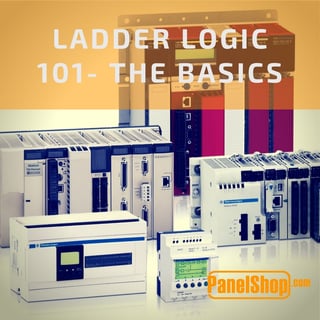 Ladder Logic 101: The Basics
Ladder Logic 101: The Basics
Anyone who has worked in automation software knows that using the right tool for the job is essential to a successful and worthwhile implementation. Recognizing this, software vendors often allow multiple programming methods to be used with their software. These fundamentally different models of computation let programmers select the most appropriate tool for their tasks, such as ladder logic.
Foundations of Ladder Logic: the Ladder Diagram
The ladder diagram evolved in the 1960s when the automotive industry needed a more flexible form of documentation for their physical relay and timer cabinets. Later, a microprocessor-based system was introduced, and it was decided that the software for the system would be designed to mirror the actual electrical ladder diagrams used to build the relay control panels. This software, called ladder logic, looks and executes very similarly to the original electrical diagram.
Rung By Rung By Rung…
The original ladder diagrams replicated relay circuits with long series of “rungs” spanning between two rails, where each rung corresponds to a certain part of the circuit. Power flows from the power bus (left rail) through a combination of normally open or normally closed contacts to power a coil. Open contacts block power and closed contacts pass power on through the coil to the ground bus (right rail). In ladder logic, each contact and coil on a logic diagram is linked to a Boolean memory location. Contacts arranged in series are compounded by a logical “and” and contacts in parallel with a logical “or.” Execution is left to right and top to bottom.
Behind the Scenes
Behind the diagram of ladder logic is an unseen scanning engine and memory management stack. Physical inputs are read and stored in a memory table. The ladder logic is run by reading and writing from the memory table for inputs, outputs, and intermediate values. At the end of the logic cycle, all the physical outputs are updated with the values from the memory table. (Many ladder representations can perform immediate reads and writes, rather than wait until the end of the execution cycle).
Functions in Ladder Logic
To handle more complex tasks, such as math, timer functionality, counters, or PID, all ladder representations today have the ability to call functions on the ladder rung. These functions typically have an input terminal to enable the function execution and an output terminal for when the function has finished successful execution. Functions dropped onto a ladder diagram will execute according to ladder diagram power flow.
Ladder Logic 101
As one of the many different types of programming methods in the industry today, it is important to understand ladder logic in order to know when to use it.. Ladder logic is most unique in its direct representation of the circuit logic it is implementing, but it is also powerful with its unseen intermediate processing and its great use of different functions.
The programmers here at PanelShop.com are experts in these areas, and they know exactly what type of tool to apply when they have a job to take care of. If you have any questions about the use of ladder logic, or some other form of controller programming language, give us a call today!
To discover what improvements your company can make to become more efficient talk to a specialist at PanelShop.com today.
Submit your quote and recieve it within 48 hours:
You May Also Be Interested In Reading

 Ladder Logic 101: The Basics
Ladder Logic 101: The Basics


